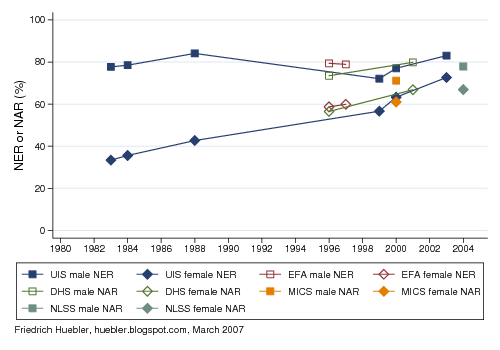- female primary school net enrollment rate below 70 percent,
- gender gap in primary education above 10 percent,
- more than 1 million girls out of school,
- included in the Education for All Fast Track Initiative,
- affected by crises like HIV/AIDS and military conflict.
Trend data on enrollment and attendance, plotted in the following graph, shows that the primary school participation rate of girls has increased substantially since the 1980s. On the other hand, the participation rate of boys has remained relatively stable. As a result, the difference between male and female enrollment or attendance rates has decreased from more than 40 percent to roughly 10 percent over the past 25 years.
Nepal: trends in primary education, 1980-2004

Data sources: UNESCO Institute for Statistics, Demographic and Health Survey, Multiple Indicator Cluster Survey, Nepal Living Standards Survey.
The graph combines data from a variety of sources.
- UIS 1980-1997: UNESCO Institute for Statistics. 1999. Online database. http://www.uis.unesco.org/en/stats/centre.htm, March 2005.
- EFA: UNESCO. 2000. Education for All 2000 assessment: A decade of education. Paris: UNESCO Institute for Statistics. CD-ROM.
- UIS 1999-present: UNESCO Institute for Statistics. 2006. Global education database. http://stats.uis.unesco.org/ReportFolders/reportfolders.aspx, October 2006.
- DHS: Demographic and Health Survey 1996 and 2001. ORC Macro. http://www.measuredhs.com.
- MICS: Multiple Indicator Cluster Survey 2000. UNICEF. http://www.childinfo.org.
- NLSS: Central Bureau of Statistics [Nepal]. 2004. Nepal living standards survey 2003/04: Statistical report. 2 vols. Vol. 1. Kathmandu: Central Bureau of Statistics.
In spite of some differences, the overall trends in enrollment and attendance are similar. Male NER or NAR values have hovered around 80 percent since the 1980s. In 1983, the NER of boys was 78 percent; in 2003, it was 83 percent. The latest data on primary school attendance is from a Nepal Living Standard Survey (NLSS) conducted in 2003/04. For boys, the net attendance rate at that time was 78 percent.
The female primary school NER was at 33 percent in 1983 but it more than doubled to 73 percent in 2003. The NAR of girls was 67 percent in 2003/04 according to the most recent household survey data. Because of the increase in primary school participation of girls, the gender parity index - the ratio of female to male NER or NAR values - grew from 0.4 in 1983 to more than 0.8 by 2003. If this trend continues, Nepal will reach gender parity in primary education in the coming years. However, additional progress is needed to reach the Millennium Development Goal of universal primary education by 2015.
Related articles
- Primary and secondary school attendance in Nepal
- Education disparity in South Asia
- Global trends in primary school enrollment, 1970-2004
- Education data from household surveys
- UNICEF priority countries for girls' education
- Official school ages: primary, secondary, and compulsory education
- United Nations Millennium Development Goals
- Education for All Fast Track Initiative
- UNESCO global education database
- Demographic and Health Surveys (DHS)
- Multiple Indicator Cluster Surveys (MICS)
Permanent URL: http://huebler.blogspot.com/2007/03/nepal-trends-in-primary-school.html
No comments:
Post a Comment